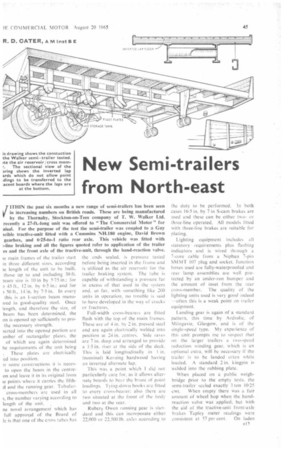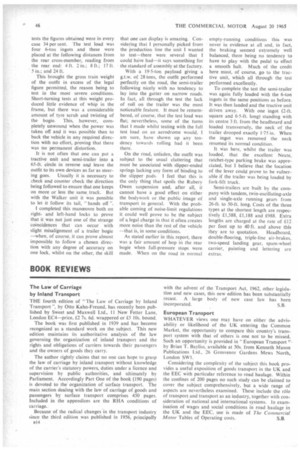New Semi-trailers from North-east
Page 47

Page 48

If you've noticed an error in this article please click here to report it so we can fix it.
iITHIN the past six months a new range of semi-trailers has been seen in increasing numbers on British roads. These are being manufactured by the Thornaby, Stockton-on-Tees company of T. W. Walker Ltd. recently a 27-ft.-long unit was offered to "The Commercial Motor" for aisal. For the purpose a the test the semi-trailer was coupled to a Guy icible tractive-unit fitted with a Cummins NH.180 engine, David Brown gearbox, and 6.25-to-I ratio rear axle. This vehicle was fitted with Aim braking and all the figures quoted refer to application of the trailer es and the front axle of the iractive-unit, through the hand-reaction valve.
le main frames of the trailer start in three different sizes. according le length of the unit to he built. those up to and including 30 ft. lean) size is 10 in by 5-75 in.: for 3 45 ft,, 12 in, by (1.5 in.; and for ) 50 ft., 14 in. by 7-5 in. In every this is an 1-section beam manusred in good-quality steel. Once length, and therefore the size, of beam has been determined, the on is opened up sufficiently to prothe necessary strength.
serted into the opened portion are imber of rectangular plates. the of which are again determined he requirements of the unit being • These plates are electrically ed into position.
)r some constructions it is necesto open the beam in the centreon and leave it in its original form le points where it carries the fifthand the running gear. lobularcross-members are used in all s, the number varying according to length of the unit. .
ne novel arrangement which has full approval of the Board of le is that one of the cross tubes has the ends sealed, is pressure tested before being inserted in the frame and is utilized as the air reservoir for the trailer braking system. The tube is capable of withstanding a pressure far in excess of that used in the system and. so far, with something like 200 units in operation, no trouble is said to have developed in the way of cracks or fractures, Full-width cross-bearers are fitted flush with the top of the main frames. These arc of 4 in. hy 2 in. pressed steel and are again electrically welded into position at 24 in. centres. Side raves are 7 in. deep and arranged to provide a 1.5 in. riser at the side of the deck. This is laid longitudinally in 1 in. (nominal) Keruing hardwood having an inverted alternate This was a point which I did not particularly care for, as it allows alternate boards to bear the brunt of point loadings. 'king-down hooks are fitted to every cross-bearer: also there are two situated at the front of the body and two at the rear.
Rubery Owen running gear is standard and this can incorporate either 22,000 or 22.500 lb. axles according to the duty to be performed. In both cases 16.5 in. by 7 in S-cant brakes are used and these can be either twoor three-line operated. All models fitted with three-line brakes are suitable for plating. .
Lighting equipment includes all statutory requirements plus flashing indicators and is wired through a 7-core cable from a Niphan 7-pin SM MT 107 plug and socket. Junction boxes used are fully-waterproofed and rear lamp assemblies are well protected by an under-run bumper and the amount of inset from the rear cross-member. The quality of the lighting units used is very good indeed ---often this is a weak point on trailer equipment.
Landing gear is again of a standard pattern, this time by Ardrolic. of AliIngavie. Glasgow, and is of the single-speed type. My experience of this unit prompts me to suspect that on the larger trailers a two-speed reduction winding gear, which is an optional extra, will he necessary if the trailer is to be landed often Nvhile loaded. A standard 2 in. kingpin is welded into the rubbing plate.
When placed on a public weighbridge prior to the ernpty tests. the semi-trailer scaled exactly 3.ton 10.25 cwt. When empty there was a fair amount of wheel hop when the handreactionvalve was applied, but With she aid of the tractive-unit front-axle brakes Tapley meter readings were
consistent at 57 per cent. On laden tests the figures obtained were in every case 34 per cent. The test load was four 6-ton ingots and these were placed at the following distances from the rear cross-member, reading from the rear end: 4 ft. 2 in.; 8 ft.; 17 ft. 5 in.; and 24 ft.
This brought the gross train weight of the outfit in excess of the legal figure permitted, the reason being to test in the most severe conditions. Short-turning tests at this weight produced little evidence of whip in the frame, but there was a considerable amount of tyre scrub and twisting of the bogie. This, however, completely unwound when the power was taken off and it was possible then to back the vehicle in any required direction with no effort, proving that there was no permanent distortion.
It is not often that one can put a tractive unit and semi-trailer into a 65-ft. circle in reverse and leave the outfit to its own devices as far as steer ing goes. Usually it is necessary to check and counter check the direction being followed to ensure that one keeps on more or less the same track. But with the Walker unit it was possible to let it follow its tail, "hands off I completed this manceuvre both on rightand left-hand locks to prove that it was not just one of the strange coincidences that can occur with slight misalignment of a trailer bogie —when, of course, it can prove almost impossible to follow a chosen direction with any degree of accuracy on one lock, whilst on the other, the skill that one can display is amazing. Considering that I personally picked from the production line the unit I wanted to test—there were several that I could have had—it says something for the standard of assembly at the factory.
With a 19-5-ton payload giving a g.t.w. of 28 tons, the outfit performed perfectly on the road, the semi-trailer following nicely with no tendency to lay into the gutter on narrow roads. lra fact, all through the test the lack of roll on the trailer was the most noticeable feature. It must be remembered, of course, that the test load was flat; nevertheless, some of the turns that 1 made whilst testing with the full test load on an aerodrome would, I am sure, have shown up any tendency towards rolling had it been there.
On the road, unladen, the outfit was subject to the usual clattering that must be associated with slipper-ended springs lacking any form of binding to the slipper padsI feel that this is the only thing that spoils the Rubery Owen suspension and, after all, it cannot have a good effect on either the bodywork or the public image of transport in general. With the probable coming of noise-limit regulations it could well prove to be the subject of 4 legal charge in that it often creates more noise than the rest of the vehicle —that is, in some conditions.
As stated earlier in this report, there was a fair amount of hop in the rear bogie when full-pressure stops were made. When on the road in normal empty-running conditions this was never in evidence at all and, in fact, the braking seemed extremely well balanced, there being no tendency to have to play with the pedal to effect a smooth halt. Much of the credit here must, of course, go to the tractive unit, which all through the test performed excellently.
To complete the test the semi-trailer was again fully loaded with the 6-ton ingots in the same positions as before. It was then landed and the tractive unit driven away. With one ingot (2-ft. square and 6-5-ft. long) standing with its centre 3 ft. from the headboard and loaded transversely, the neck of the trailer drooped exactly 1-75 in. When the ingot was removed the neck resumed its normal condition.
It was here, whilst the trailer was loaded, that the excellent Neate, ratchet-type parking brake was appreciated, but I believe that the location of the lever could prove to be vulnerable if the trailer was being loaded by fork-lift truck.
Semi-trailers are built by the company with tandem, twin-oscillating-axle and single-axle running gears from 26-ft. to 50-ft. long. Costs of the three types at the shortest length are respectively £1,588, £1,188 and £988. Extra lengths arc charged at the rate of £12 per foot up to 40 ft. and above this they are to quotation. Headboard. double-flooring, triple-line air-brakes, two-speed landing gear, spare-wheel carrier, painting and lettering are extras.




















































































































